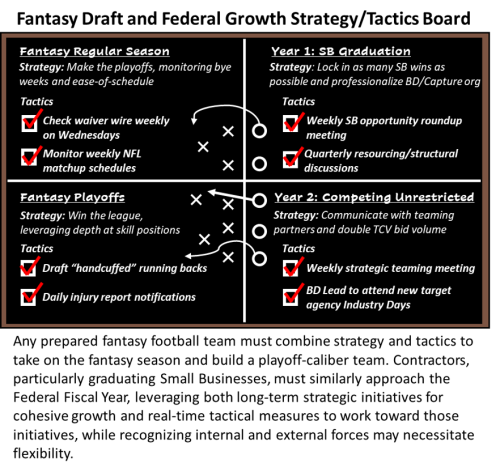September 2023 – Vol. 12; Issue 9
DWPA Staff
on
September 14, 2023
Drafting Your Way to Federal Growth: Strategy vs. Tactics
- In designing a successful growth plan, federal contractors should balance strategic steps with tactical actions.
- Fall brings a busy football season and the conclusion of FY23. Like any prepared fantasy team charting its path to the playoffs, businesses should synthesize strategy and tactics to hit revenue targets.
- How do you win the game? What is your objective? Who do you want on your team? When do you need them? Strategic thinking necessitates a broad view across the playing field.
- Are you balancing time spent on delivery vs. growth? When should you attend industry days? How many proposal writers do you need on each team? What setbacks do you anticipate? Consider regular huddles to implement tactics toward achieving strategic expansion.
- A plan that balances strategy and tactics focuses on major objectives and practical measures. This equilibrium helps to ensure that you’re not lost in the big picture, and that you can call an audible should the field read be different than anticipated.
- Develop your Madden Chart, prepare a winning game plan with ground-level tactics that lead you to your strategic endzone.
You’re on the Clock!
The leaves are falling, the air is crisp, and laptops are humming as fantasy football owners log back into their long-dormant leagues. While federal contractors simultaneously prepare for the final days of FY23, both groups find themselves asking the same question: how to balance a coherent growth strategy with clear, effective tactics for the coming months? After all, fantasy football drafting strategies set the tone for the season—relying on trades from stingy fellow owners or grasping for straws on the waiver wire are easy ways to end up with an embarrassing tattoo or wearing your rival’s jersey for a day. Just as fantasy owners must carefully select their lineup, contractors must develop clearly defined and reasonably set strategic initiatives to empower federal growth for the year ahead. Prioritization of a small number of high-impact initiatives, reinforced with a tactical approach that includes specific assignments and actions, can help companies create a focused, attainable path to growth.
Sleepers, Bye Weeks, and “Do Not Drafts”
If fantasy owners could perfectly balance ease-of-schedule, high-value players, and a healthy bye week mix, anybody could be Matthew Berry or Field Yates. The fact is every fantasy owner is going to give up something when the draft jingle chimes. In the same vein, contractors cannot expect to pursue every single strategic initiative brainstormed at the annual strategic offsite. Build out a team with uniformly spread bye weeks (or an evenly distributed pipeline), and you may find yourself having to sideline your ease-of-schedule strategy (or focus mostly on big-swing, low p(win) opportunities). Draft Patrick Mahomes in the second round (or make hiring a dedicated capture manager an immediate priority) and you may not have enough depth in skill positions (or enough funds to train internal resources). Weighing the importance, value, and attainability of strategic initiatives against each other is key before diving into pure tactics.

Setting Your Lineup
Strategies provide overarching guidance—fast, sustainable federal growth is underlaid by a set of dedicated, tactical approaches which outline clear actions and responsibilities. The same is true in fantasy football, where this realization happens quickly—once the dust from the draft settles, Week 1 lineup setting is usually right around the corner. For those “handcuffing” star running backs with their backups, a tactical approach of monitoring the injury report before kickoff will ensure they are never left with a goose egg. In the federal world, smart tactics similarly make up the backbone of an effective strategy. Planning to expand into a new customer? Targeting dates for executive meetings with agency leaders might be a good start. Aiming for $50M in TCV submission before the end of the quarter? Assigning capture and proposal managers to specific deals can make that number tangible. Just as fantasy owners set their lineup each week, companies in the federal market should consider quarterly or even monthly reviews of strategic goals and tactical approaches.
Fumble!
No matter the amount of strategy or tactics, fantasy owners and federal contractors know well that both the fantasy world and the federal market bring their fair share of surprises. A fantasy draft strategy that relies on ease-of-schedule would normally employ a tactic of rotating players during their weeks facing elite opponents. However, when your leading scorer inevitably goes down with an injury, plans will change – suddenly, your tactic of reviewing other teams’ trade needs every Tuesday becomes crucial. The balance of strategy and tactics is useful in promoting flexibility. An overarching strategy can keep a singular focus, while numerous tactical avenues keep things flexible enough to weather nasty surprises. For example, under a strategic goal to win at least 1 of 3 major bids, the tactical decision to implement a weekly review of capture and proposal resource allocation can provide quick response to sudden RFP requirement changes. In the demanding worlds of fantasy football and GovCon, strategy and tactics must coexist in harmony.
Mock Draft of Growth Strategy and Tactics
- WR1: Run up the score—strategically anchor company growth goals on clear comparative advantages
- RB1: Every-game starters—understand that delivery team needs may require tactical flexibility within growth strategies
- WR2: Strength-of-schedule play—lay out the year ahead for major capture efforts and large bids
- QB1: Team leader(s)—hold annual exec gatherings that set the strategic and tactical tone for the upcoming FY
- RB2: The “workhorses”—assemble a dedicated capture and proposal team that meets regularly
- TE1: Unsung heroes—mix in smaller, more attainable strategic goals focused on building internal capacity
- D/ST: The elite, competitive edge—“stream” teaming partners when opportunities exceed internal capabilities
- K: The longshot—low p(win), high-value wins are rare, but can result in tremendously quick growth
Jack Jacobs
757-692-6777
jack.jacobs@dwpassociates.com
Shera Bhala
410-544-5254
shera.bhala@dwpassociates.com
Jessica Butturff
703-786-1841
jessica.butturff@dwpassociates.com



